About Xi’an Introduction Called Chang’an in ancient times, Xi’an served as the capital of 13 dynasties. Now it is known as one of the four civilized ancient capitals with Athens, Cairo, and Rome. Xi’an is located in the Guan Zhong Basin in the middle reaches of the Yellow River basin in the hinterland of China. Geographically, it is high in the southern region and low in the northern. The Qinling Mountains, the dividing marker between North and South China, lie to the south of the city with a ridge ranging from 2,000-3,200 meters above sea level. Xi’an experiences a monsoon
climate in a warm temperature zone with clearly defined four seasons, and moderate rainfall. The golden seasons for traveling in Xi’an are the warm, blossomy spring from March to May and the cool autumn from September to November. As the capital city of Shaanxi Province with a population of 7 million, Xi’an is a main industry base of Northwest China, among whose most important industrial concerns are machinery, electrical equipment, TV, aviation and light industry. There are more than 500 scientific research institutions and about 100 colleges and universities. At present, Xi’an has already become a modern international metropolis with thriving economy, scenic environment, and civilized social order. 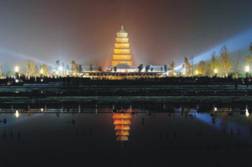 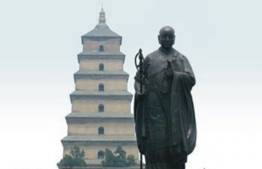 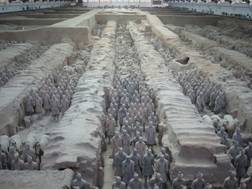 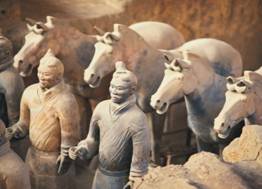 Attractions in Xi'an The continuous history of Xian has apparently resulted in its magnificent culture. Today's Xian is a world famous tourist city and an inexhaustible treasure house of cultural relics. Now heads of state from many countries and people from all walks of life come to the city to broaden their knowledge of Chinese civilization. Foremost is the China's greatest archeological excavation, the Terra Cotta Warriors and Horses. Life size terracotta figures of warriors and horses arranged in battle formations symbolically guard the Mausoleum of Emperor Qin Shi Huang , the first emperor of the Qin Dynasty (246-209B.C). The State Council authorized the building of a museum on the site in 1975 for the protection of the discovery. So far, altogether over 7,000 pottery soldiers, horses, chariots, and even weapons have been unearthed and displayed in the museum. It is cited as the 'Eighth Wonder of the World' and was listed by UNESCO in 1987 as one of the world cultural heritages. Spending some time at the Huaqing Hot Springs on the way back from the Terra Cotta Army site is a must for every visitor to Xian. For centuries emperors came here to bathe and enjoy the scenic beauty, and it has been a favorite spa since the Tang Dynasty (618-907 A.D). The palace complex has also been the scene of political intrigue, so there is plenty of interest to discover during your visit. Covering an area of about 100,000 square meters, the Banpo Village Remains was a village settlement of the earliest inhabitants of Xian, typical of the Neolithic Yangshao culture. At this site, archaeologists have discovered nearly 10,000 production tools and daily utensils of various kinds and the remains of 45 houses, 200 cellars, 6 pottery kilns, 174 adults' burial pits and 73 children's burial jars. Every Ming city (1368-1644) had a bell tower and a drum tower. The bell was sounded at dawn and the drum at dusk. The two buildings at Xian are the best known in China. The Bell Tower was built in the city center and from the top can enjoy a panoramic view of the whole of Xian. Not far away to the west is the Drum Tower , a large drum inside was for marking the passage of time each night in ancient times. Now, they are outstanding examples of the ancient architecture of Xian. Housing more than 2,300 famous steles and inscribed memorial tablets of the Han, Wei, Sui, Tang, Yuan, Ming, Qing dynasties and known as the largest 'stone-book warehouse’ in China, the Forest of Stone Steles in Xian is a treasure house of calligraphic art. It is situated on the street Sanxue Jie, near the south gate of the Xian City Wall . The City Wall in Xian is the most complete city wall to survive in China, as well being one of the largest ancient military defensive systems in the world. It was built first in the early Ming Dynasty (1368-1644) and renovated in recent years. Outside the city wall is a moat. A circular park has now been built along the high wall and the deep moat. Xian is the capital city of the prosperous Tang Dynasty (618-907). Many visitors come here in the hope of experiencing the glorious Tang culture. "Back to Tang Dynasty" is what echoes in their minds. Tang Paradise, opened in 2005, is the biggest Tang culture theme park which is praised as "Garden of History", "Garden of Nature" and "Garden of Human Culture". Tang Dynasty Music and Dance Show, by presenting an outstanding performance of Tang’s dance and music, explains to visitors the splendid culture and living style of that remote dynasty. These are the two sites recommended to you to have a glance at Tang Dynasty. If you are interested in archaeology, you can visit the Mausoleum of Western Han Emperor Liu Qi (Hanyangling), the joint tomb of Liu Qi, a notable emperor in Western Han Dynasty (206 BC-220AD), and his empress, Empress Wang. Qian Mausoleum (Qian Ling), the joint mausoleum of Emperor Gaozong and his empress Wu Zetian, the only woman ruler in Chinese history. Also Western Zhou Chariot Burial Pit, a right place to understand ancient Chinese burial system. The natural scenery in and around Xian is also worth mentioning. Mt. Huashan, one of the five sacred mountains in China, is famous for precipitous crags, narrow and steep mountain paths. Taibai Mountain National Forest Park is noted for picturesque mountainous scenery, lively hot spring and profound cultural relics. Xian has many temples. Ba Xian An Monastery (Temple of the Eight Immortals) is an important and popular spot celebrating Taoism; Daxingshan Temple is one of the oldest Buddhist temples in China; Green Dragon Temple (Qinglong Temple) is a notable Buddhist temple built in Tang Dynasty (618-907)… Moslem Street (Huimin Jie) is an old street paved with bluestone plate, both sides of which stand a row of muslin restaurants decorated in Ming (1368-1644) and Qing (1644-1911) Dynasties’ styles. This is the right place to taste Xian snacks, and maybe you can have a chance to Visit A Local Family to experience locals’ life on the street. Another street you’d better not miss is Shuyuan (Academy of Classical Learning) Gate which is a cultural street also designed in ancient architectural style. Strolling on this street, you can buy many articles unique to China, such as the four treasures of study, calligraphic works and paintings like Peasant Painting, Huxian County. Additional attractions are the Big Wild Goose Pagoda and Small Wild Goose Pagoda of the Tang Dynasty (618-907 A.D), while worshipers still frequent the Great Mosque and the famous Famen Temple noted for its collection of Sakyamuni's relics. Xian Museum is the treasure house of 130,000 precious cultural relics belonging to several dynasties. These together with the magnificent Shaanxi History Museum are all highly recommended attractions to be visited when you come to Xian. Qinling Zoological Park provides visitors with a fresh and free environment to watch animals. Moreover, a unique type of dwelling Farmers' Caves, exists mainly in northern part of Shaanxi Province, is also worth visiting. 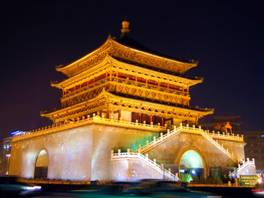 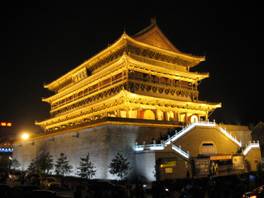  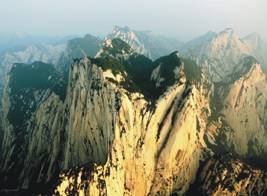 |


